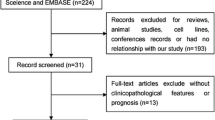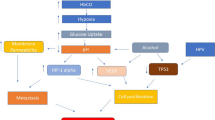Abstract
Oral squamous cell carcinoma (OSCC) is the most common oral cancer. Hypoxia inducible factor (HIF) is involved in many malignant tumors’ growth and metastasis and upregulated by hypoxia, including oral cancer. Many studies have studied about the prognostic value of HIF expression in OSCC; however, they do not get the consistent results. Therefore, this study explored the correlation between the HIF expression and the prognosis of OSCC. It conducted a meta-analysis of relevant publications searched in the Web of Science, PubMed, and ISI Web of Knowledge databases. Totally, this study identified 12 relevant articles reporting a total of 1112 patients. This analysis revealed a significant association between increased risk of mortality (RR = 1.20; 95 % CI 0.74–1.95; I 2 85.4 %) and overexpression of HIFs. Furthermore, different HIF isoforms were associated with overall survival [HIF-1α (RR = 1.18; 95 % CI 0.66–2.11; I 2 87.2 %) and HIF-2α (RR = 1.40; 95 % CI 0.93–2.09; I2 0.0 %)]. These results show that overexpression of HIFs, regardless of whether the HIF-1α or HIF-2α isoforms are overexpressed is significantly associated with increased risk of mortality in OSCC patients. In this study, the funnel is symmetric, suggesting existed no publication bias.



Similar content being viewed by others
References
Rajwar YC, Jain N, Bhatia G, Sikka N, Garg B, Walia E. Expression and significance of cadherins and its subtypes in development and progression of oral cancers: a review. J Clin Diag Res JCDR. 2015;9(5):ZE05–7. doi:10.7860/jcdr/2015/11964.5907.
Feller LL, Khammissa RR, Kramer BB, Lemmer JJ. Oral squamous cell carcinoma in relation to field precancerisation: pathobiology. Cancer Cell Int. 2013;13:31. doi:10.1186/1475-2867-13-31.
Kimple AJ, Welch CM, Zevallos JP, Patel SN. Oral cavity squamous cell carcinoma—an overview. Oral health Dent Manage. 2014;13(3):877–82.
Mangalath U, Aslam SA, Abdul Khadar AH, Francis PG, Mikacha MS, Kalathingal JH. Recent trends in prevention of oral cancer. J Int Soc Prev Commun Dent. 2014;4 Suppl 3:S131–8. doi:10.4103/2231-0762.149018.
Wang GL, Semenza GL. Characterization of hypoxia-inducible factor 1 and regulation of DNA binding activity by hypoxia. J Biol Chem. 1993;268(29):21513–8.
Chun YS, Kim MS, Park JW. Oxygen-dependent and -independent regulation of HIF-1alpha. J Korean Med Sci. 2002;17(5):581–8.
Zhao J, Du F, Luo Y, Shen G, Zheng F, Xu B. The emerging role of hypoxia-inducible factor-2 involved in chemo/radioresistance in solid tumors. Cancer Treat Rev. 2015;41(7):623–33. doi:10.1016/j.ctrv.2015.05.004.
Stang A. Critical evaluation of the Newcastle-Ottawa scale for the assessment of the quality of nonrandomized studies in meta-analyses. Eur J Epidemiol. 2010;25(9):603–5. doi:10.1007/s10654-010-9491-z.
Spruance SL, Reid JE, Grace M, Samore M. Hazard ratio in clinical trials. Antimicrob Agents Chemother. 2004;48(8):2787–92. doi:10.1128/aac.48.8.2787-2792.2004.
Zhang J, Yu KF. What’s the relative risk? A method of correcting the odds ratio in cohort studies of common outcomes. Jama. 1998;280(19):1690–1.
Egger M, Davey Smith G, Schneider M, Minder C. Bias in meta-analysis detected by a simple, graphical test. BMJ (Clin Res Educ). 1997;315(7109):629–34.
Fillies T, Werkmeister R, van Diest PJ, Brandt B, Joos U, Buerger H. HIF1-alpha overexpression indicates a good prognosis in early stage squamous cell carcinomas of the oral floor. BMC Cancer. 2005;5:84. doi:10.1186/1471-2407-5-84.
Lin PY, Yu CH, Wang JT, Chen HH, Cheng SJ, Kuo MY, et al. Expression of hypoxia-inducible factor-1 alpha is significantly associated with the progression and prognosis of oral squamous cell carcinomas in Taiwan. J Oral Pathol Med Off Pub Int Assoc Oral Pathol Am Acad Oral Pathol. 2008;37(1):18–25. doi:10.1111/j.1600-0714.2007.00571.x.
Zhu GQ, Tang YL, Li L, Zheng M, Jiang J, Li XY, et al. Hypoxia inducible factor 1 alpha and hypoxia inducible factor 2 alpha play distinct and functionally overlapping roles in oral squamous cell carcinoma. Clin Cancer Res Off J Am Assoc Cancer Res. 2010;16(19):4732–41. doi:10.1158/1078-0432.ccr-10-1408.
Eckert AW, Lautner MH, Schutze A, Bolte K, Bache M, Kappler M, et al. Co-expression of Hif1alpha and CAIX is associated with poor prognosis in oral squamous cell carcinoma patients. J Oral Pathol Med Off Publ Int Assoc Oral Pathol Am Acad Oral Pathol. 2010;39(4):313–7. doi:10.1111/j.1600-0714.2009.00829.x.
Eckert AW, Lautner MH, Schutze A, Taubert H, Schubert J, Bilkenroth U. Coexpression of hypoxia-inducible factor-1alpha and glucose transporter-1 is associated with poor prognosis in oral squamous cell carcinoma patients. Histopathology. 2011;58(7):1136–47. doi:10.1111/j.1365-2559.2011.03806.x.
Liang X, Zheng M, Jiang J, Zhu G, Yang J, Tang Y. Hypoxia-inducible factor-1 alpha, in association with TWIST2 and SNIP1, is a critical prognostic factor in patients with tongue squamous cell carcinoma. Oral Oncol. 2011;47(2):92–7. doi:10.1016/j.oraloncology.2010.11.014.
dos Santos M, Mercante AM, Louro ID, Goncalves AJ, de Carvalho MB, da Silva EH, et al. HIF1-alpha expression predicts survival of patients with squamous cell carcinoma of the oral cavity. PLoS One. 2012;7(9):e45228. doi:10.1371/journal.pone.0045228.
Mendes SO, dos Santos M, Peterle GT, Maia Lde L, Stur E, Agostini LP, et al. HIF-1alpha expression profile in intratumoral and peritumoral inflammatory cells as a prognostic marker for squamous cell carcinoma of the oral cavity. PLoS One. 2014;9(1):e84923. doi:10.1371/journal.pone.0084923.
Wilson WR, Hay MP. Targeting hypoxia in cancer therapy. Nat Rev Cancer. 2011;11(6):393–410. doi:10.1038/nrc3064.
Beasley NJ, Leek R, Alam M, Turley H, Cox GJ, Gatter K, et al. Hypoxia-inducible factors HIF-1alpha and HIF-2alpha in head and neck cancer: relationship to tumor biology and treatment outcome in surgically resected patients. Cancer Res. 2002;62(9):2493–7.
Gong L, Zhang W, Zhou J, Lu J, Xiong H, Shi X, et al. Prognostic value of HIFs expression in head and neck cancer: a systematic review. PLoS One. 2013;8(9):e75094. doi:10.1371/journal.pone.0075094.
Hong A, Zhang M, Veillard AS, Jahanbani J, Lee CS, Jones D, et al. The prognostic significance of hypoxia inducing factor 1-alpha in oropharyngeal cancer in relation to human papillomavirus status. Oral Oncol. 2013;49(4):354–9. doi:10.1016/j.oraloncology.2012.11.006.
Imamura T, Kikuchi H, Herraiz MT, Park DY, Mizukami Y, Mino-Kenduson M, et al. HIF-1alpha and HIF-2alpha have divergent roles in colon cancer. Int J Cancer J Int Cancer. 2009;124(4):763–71. doi:10.1002/ijc.24032.
Acker T, Diez-Juan A, Aragones J, Tjwa M, Brusselmans K, Moons L, et al. Genetic evidence for a tumor suppressor role of HIF-2alpha. Cancer Cell. 2005;8(2):131–41. doi:10.1016/j.ccr.2005.07.003.
Raval RR, Lau KW, Tran MG, Sowter HM, Mandriota SJ, Li JL, et al. Contrasting properties of hypoxia-inducible factor 1 (HIF-1) and HIF-2 in von Hippel-Lindau-associated renal cell carcinoma. Mol Cell Biol. 2005;25(13):5675–86. doi:10.1128/mcb.25.13.5675-5686.2005.
Covello KL, Simon MC, Keith B. Targeted replacement of hypoxia-inducible factor-1alpha by a hypoxia-inducible factor-2alpha knock-in allele promotes tumor growth. Cancer Res. 2005;65(6):2277–86. doi:10.1158/0008-5472.can-04-3246.
Holmquist-Mengelbier L, Fredlund E, Lofstedt T, Noguera R, Navarro S, Nilsson H, et al. Recruitment of HIF-1alpha and HIF-2alpha to common target genes is differentially regulated in neuroblastoma: HIF-2alpha promotes an aggressive phenotype. Cancer Cell. 2006;10(5):413–23. doi:10.1016/j.ccr.2006.08.026.
Semenza GL. Hypoxia-inducible factors: mediators of cancer progression and targets for cancer therapy. Trends Pharmacol Sci. 2012;33(4):207–14. doi:10.1016/j.tips.2012.01.005.
Astekar M, Joshi A, Ramesh G, Metgud R. Expression of vascular endothelial growth factor and microvessel density in oral tumorigenesis. J Oral Maxillofac Pathol JOMFP. 2012;16(1):22–6. doi:10.4103/0973-029x.92968.
Liang X, Yang D, Hu J, Hao X, Gao J, Mao Z. Hypoxia inducible factor-alpha expression correlates with vascular endothelial growth factor-C expression and lymphangiogenesis/angiogenesis in oral squamous cell carcinoma. Anticancer Res. 2008;28(3A):1659–66.
Acknowledgments
This study was financially supported by National Natural Science Foundation of China (81302351), Jiangsu Provincial Natural Science Foundation (BK 20131080), Distinguished young investigator project of Nanjing (JQX14010).
Author information
Authors and Affiliations
Corresponding author
Ethics declarations
Conflicts of interest
None
Rights and permissions
About this article
Cite this article
Qian, J., Wenguang, X., Zhiyong, W. et al. Hypoxia inducible factor: a potential prognostic biomarker in oral squamous cell carcinoma. Tumor Biol. 37, 10815–10820 (2016). https://doi.org/10.1007/s13277-016-4976-3
Received:
Accepted:
Published:
Issue Date:
DOI: https://doi.org/10.1007/s13277-016-4976-3




